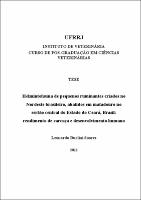| ???jsp.display-item.social.title??? |


|
Please use this identifier to cite or link to this item:
https://tede.ufrrj.br/jspui/handle/jspui/3505| ???metadata.dc.type???: | Tese |
| Title: | Helmintofauna de pequenos ruminantes criados no Nordeste brasileiro, abatidos em matadouro no sertão central do Estado do Ceará, Brasil: rendimento de carcaça e desenvolvimento humano. |
| Other Titles: | Helmintofauna of small ruminants raised in northeastern Brazil, slaughtered in a slaughterhouse in the central hinterland of the state of Ceará, Brazil: carcass yield and human development |
| ???metadata.dc.creator???: | Soares, Leonardo Burlini  |
| ???metadata.dc.contributor.advisor1???: | Grisi, Laerte |
| First advisor-co: | Serra-Freire, Nicolau Maués da |
| ???metadata.dc.contributor.referee1???: | Serra-Freire, Delir Correa Gomes Maués da |
| ???metadata.dc.contributor.referee2???: | Knoff, Marcelo |
| ???metadata.dc.contributor.referee3???: | Felizardo, Nilza Nunes |
| ???metadata.dc.contributor.referee4???: | Medeiros, Simoni Machado de |
| ???metadata.dc.description.resumo???: | Entre agosto de 2010 e maio de 2011 foi desenvolvido estudo sobre o parasitismo nos órgãos e glândulas anexas do sistema gastrintestinal de caprinos e ovinos criados nos Municípios de Quixadá, Choró, Banabuiú, Quixeramobim, Ibicuitinga, Morada Nova, Jaguaretama, Itapiúna e Ibaretama, representando amostra das regiões do Sertão Central e Baixo Jaguaribe, do Estado do Ceará, encaminhados para abate no Matadouro Público Municipal de Quixadá. Simultaneamente foram recolhidos dados biométricos de crianças (idade, peso corporal e altura) com a idade variando entre três meses e seis anos, nascidas e domiciliadas nos Municípios de Quixadá e Morada Nova, acompanhadas pelo Programa Saúde da Família, que foram analisados e comparados com os das escalas padrões de referência para a população brasileira. Foi comprovada a infecção (parasitismo) por metacestóides de Taenia hydatigena (forma larvar), em diversos sítios dos hospedeiros (fígado, omento, vesícula biliar e serosas do duodeno, abomaso, piloro, útero, intestino grosso, bexiga e rumem) e pela forma adulta de Moniezia expansa, no intestino delgado; por nematóides no abomaso e intestino delgado (Haemonchus contortus, Trichostrongylus colubriformis, T. axei e Cooperia punctata), e no intestino grosso (Oesophagostomum columbianum, Trichuris globulosa e T. ovis), sendo a maior prevalência para H. contortus. Foram confirmadas as hipóteses de baixo rendimento de carcaça dos ovinos e caprinos, e a deficiência nutricional da população de origem ameríndia, com tradição no consumo de proteína de origem animal; há sub-nutrição e desnutrição, identificadas pelos dados biométricos, e também há casos de obesidade em número significativamente menor do que acontece na população brasileira de referência. |
| Abstract: | From August 2010 to May 2011 was conducted a study about the parasitism in the organs and attached glands of the gastrointestinal system of goats and sheeps reared in the municipalities of Quixadá, Choró, Banabuiú, Quixeramobim, Ibicuitinga, Morada Nova, Jaguaretama, Itapiúna and Ibaretama, representing a sample of the regions of Central Hinterland and Lower Jaguaribe, sent for slaughter in the municipal public slaughterhouse of Quixadá, state of Ceará. Were simultaneously collected biometric data of children between three months and six years old, born and domiciled in the municipalities of Quixadá and Morada Nova, state of Ceará, accompanied by the Family Health Program, which were compared with the scale standards of reference for the Brazilian population. The study was finished at the ninth month because of the interdiction of the establishment in May 2011. It was showed the parasitism by cestodes of the species Taenia hydatigena (larval form), in a variety of sites (liver, omentum, gallbladder and serosas of duodenum, abomasum, pylorus, uterus, colon, bladder and rumen) and by adult form of Moniezia expansa, in small intestine; by nematodes in abomasum and small intestine (Haemonchus contortus, Trichostrongylus colubriformis, T. axei and Cooperia punctata), and in large intestine (Oesophagostomum columbianum, Trichuris globulosa and T. ovis), with the highest prevalence presented by H. contortus. It was confirmed the hypothesis of low-income housing of sheep and goats, and nutritional deficiency in the population of amerindian heritage, with tradition in the consumption of animal protein; there are sub-nutrition and malnutrition, identified by biometrics data, and there are also cases of obesity in significantly fewer than what happens in the Brazilian population of reference. |
| Keywords: | Helmintos parasitismo em pequenos ruminantes sub-nutrição humana polígono das secas Helminths small ruminants parasitism human sub-nutrition polygon of droughts |
| ???metadata.dc.subject.cnpq???: | Medicina Veterinária |
| Language: | por |
| ???metadata.dc.publisher.country???: | Brasil |
| Publisher: | Universidade Federal Rural do Rio de Janeiro |
| ???metadata.dc.publisher.initials???: | UFRRJ |
| ???metadata.dc.publisher.department???: | Instituto de Veterinária |
| ???metadata.dc.publisher.program???: | Programa de Pós-Graduação em Ciências Veterinárias |
| Citation: | SOARES, Leonardo Burlini. Helmintofauna de pequenos ruminantes criados no Nordeste brasileiro, abatidos em matadouro no sertão central do Estado do Ceará, Brasil: rendimento de carcaça e desenvolvimento humano.. 2012. 49 f. Tese (Programa de Pós-Graduação em Ciências Veterinárias) - Universidade Federal Rural do Rio de Janeiro, Seropédica. |
| ???metadata.dc.rights???: | Acesso Aberto |
| URI: | https://tede.ufrrj.br/jspui/handle/jspui/3505 |
| Issue Date: | 25-Feb-2012 |
| Appears in Collections: | Doutorado em Ciências Veterinárias |
Files in This Item:
| File | Description | Size | Format | |
|---|---|---|---|---|
| 2012 - Leonardo Burlini Soares.pdf | 2012 - Leonardo Burlini Soares | 2.15 MB | Adobe PDF |  Download/Open Preview |
Items in DSpace are protected by copyright, with all rights reserved, unless otherwise indicated.




